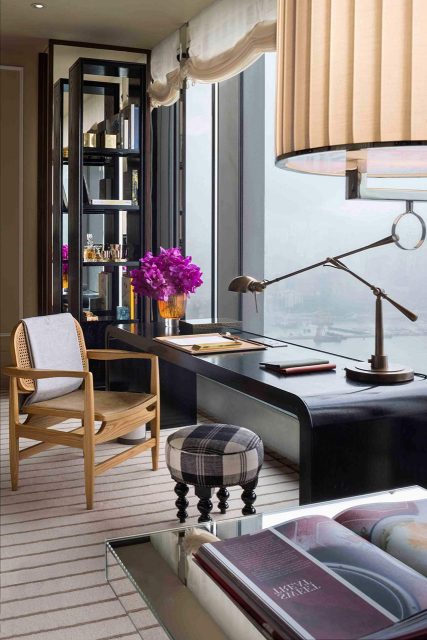It’s been something of a homecoming for Ed Ng and Terence Ngan of AB Concept. We’re taking in the 270-degree views of Victoria Harbour from the corner conference room of their brand new 4,000-square-foot office, a completely novel vantage point that wasn’t possible until the opening of K11 Atelier – the 66-storey crown jewel of Tsim Sha Tsui’s vast Victoria Dockside development – earlier this year.
“When I was a kid, my mom used to work right there in Star House,” says Ed as he points excitedly down the length of Salisbury Road, before swivelling around and turning his attention to a campus of red brick buildings. “And right there was where I went to school, in Polytechnic University. Now, I’m right in the middle. It’s all new but so familiar.”
Indeed, the concept of home, history and a sense of place have factored heavily into the 20-year-long oeuvre of Ed and Terence, which spans Asia’s most exquisite bars, restaurants and hotels and was made the focus of a standalone Assouline tome last year. Take their designs for Statement, The Dispensary and The Chinese Library, a trio of F&B outlets that inhabit the top floor of Tai Kwun’s former police mess hall, which deftly incorporate references from the building’s vaunted history into the opulent interiors. Or consider the Rosewood Sanya, which the duo sought to emulate the feeling of a private residence with the use of soft neutrals, plush textiles, and curated displays of art, books and objets d’art found throughout.
This approach naturally extends to AB Concept’s office spaces, of which there have been many throughout the years. The first was in the Star Street Precinct where the team sat around a single conference table, before subsequent moves to Causeway Bay and Lai Chi Kok, where the firm last inhabited an industrial space so large that “you could literally rollerskate in it,” Ed recalls. However, the space eventually proved to be impractical, hindering their creative process and leading Ed and Terence to yearn for a return to the early days, where serendipity and experimentation reigned supreme.
Hence, when New World Development director and longtime friend Adrian Cheng offered them a space in K11 Atelier that was a quarter of the size yet came with inspiring harbour views, the designers pounced on the opportunity. It also helps that AB Concept is involved in the design of the soon-to-be-opened K11 Musea just downstairs – billed as a museum-retail complex that will feature a cavernous, earth-toned interior full of ribbon-like elements and vertical greenery.
A return to a smaller space served as a boon for creativity, with the duo going so far as to custom-design a hexagonal workstation for the new office. Resembling a Penrose triangle when viewed from above, the design seats three, offering each user an envy-inducing amount of desk space while fostering collaboration by clustering creative minds together. However, these workstations prove to be the exception to the many original mid-century furniture pieces scattered throughout – Frank Lloyd Wright’s Taliesin II floor lamp in cherry wood, a pair of Peter Hvidt and Orla Mølgaard-Nielsen’s Easy teak lounge chairs – in another testament to Ed and Terence’s eye for heritage.
Of course, there’s the risk that they’ll get damaged but that’s life, and then it becomes part of the story of that piece of furniture.
Ed Ng, AB Concept co-founder
“Some of our friends would ask why we put such expensive items in the office, but we feel that there’s no point if we store them in a warehouse,” Ed explains. “Of course, there’s the risk that they’ll get damaged but that’s life, and then it becomes part of the story of that piece of furniture.” The art, meanwhile, is unfailingly colourful and lively, and cycled into the office from the designers’ six homes scattered around the world, from Tokyo and Taipei to Milan and Karuizawa. “This is almost like our seventh home!”
In an era where offices are increasingly becoming a thing of the past, AB Concept’s new workspace feels like a viable model for the evolution of the office into the future. The key is “about how to make it a home, and in real homes it’s all about how you curate things,” Ed reveals. “Not just within a certain design period, but the period of your whole life.”
Editor
Gavin YeungCredit
Photos: Calvin Sit










